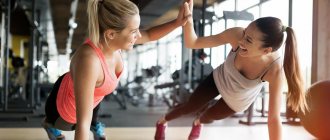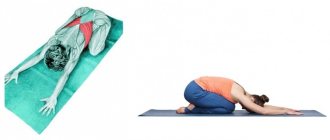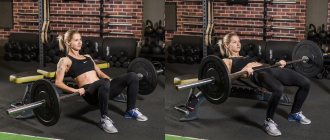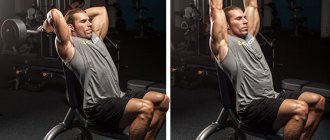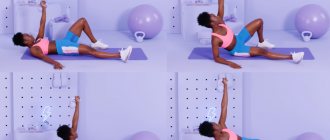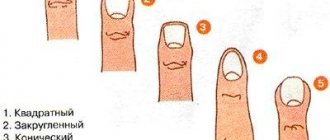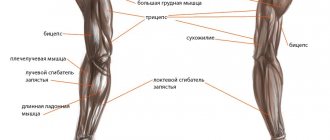What you need to know about the cervical spine
The muscles of the cervicothoracic zone of the human body can be actually cervical or simply passing through this area. All of them can be:
- median: with fibers located longitudinally. Responsible for the functioning of the larynx and jaw area.
- lateral: with fibers located obliquely. It is they who are trained, since the tilt of the head and turns of the neck depend on the work of these muscles, they help with breathing, protect the trachea and upper vertebrae.
- The shoulder and trapezius muscles, which are directed from the shoulder blade to the spine, are also responsible for the appearance and strengthening of the neck.
The cervical region is muscles, vertebrae, nerves, that is, an extremely vulnerable area of the human body. Therefore, it is recommended to develop a system of physical exercises with the participation of a specialist. Incorrect and awkward movements, excessive loads are fraught with various problems, including osteochondrosis, back pain, and vertebral displacement.
The cervical region is a very vulnerable area of the human body.
Contraindications to development of the cervical spine
If you are going to strengthen your neck muscles, follow these important rules. First of all, you need to visit a doctor and make sure that you can develop this zone. Neck exercises, in particular, are contraindicated if:
- neck diseases in the acute phase
- spinal injuries
- tachycardia
- high blood pressure
- infectious diseases
Perhaps, to begin with, a specialist will recommend you a therapeutic set of exercises. In any case, all elements of physical exercises to strengthen the neck muscles must be performed smoothly, without making sudden movements, and if pain occurs, interrupt the exercises. You cannot do a large number of elements from the very first lessons. Experienced trainers advise gradually increasing the load on the muscles, increasing it as the muscles strengthen.
If your job forces you to sit in one place a lot, be sure to do simple neck exercises every day, both at home and in the office.
SportSovety.ru
Anyone who wants to know how to pump up their neck with dumbbells should remember that exercises on the neck muscles must be performed carefully so as not to injure the neck.
There are neck exercises for both home and gym use. It is advisable that you have a coach or mentor with you at first. In the article you will learn how to pump up your neck with dumbbells, what you need to know for this and what are the correct controls and techniques with dumbbells to pump up your neck. How can you replace dumbbells if you don’t have them and you don’t want to buy them or go to the gym to train. Find out: how to pump up your neck at home.
How to pump up your neck with dumbbells
To pump up your neck with dumbbells, you need to write your goal in large letters on a piece of paper and hang it in a visible place so that you can see this goal at least 2 times a day. You also need to write next to the goal the date by which you want to achieve the result you need.
Also, in order to pump up your neck with dumbbells, you need to draw up a training plan so that by training according to it you will achieve the desired result. Your training plan should include all the exercises you need, sets, reps, timing, and schedule. Find out: how to pump up your neck on the horizontal bar and uneven bars.
How to pump up your neck with dumbbells - exercises
To pump up your neck with dumbbells, you can replace them with water bottles or a backpack. Perform neck exercises 3 times a week, every other day, so that the muscles can rest well and avoid injury.
Hold dumbbells for a while
Take the average weight of dumbbells that you can lift and just stand with them, keeping your back straight for 5-10 minutes. If there is no strain on your neck, do more weight.
Swing dumbbells to the sides
To pump up your neck with dumbbells, take 2 dumbbells and simply swing to the sides, but carefully so as not to injure your neck muscles. Find out: how to pump up your neck muscles at home.
How to pump up your neck with dumbbells - recommendations
To pump up your neck with dumbbells, you need to do simple exercises and warm-up before exercise. It is also advisable not to do heavy loads. Start with simple exercises, neck exercises and finish with more complex exercises.
It is not recommended to perform exercises with heavy weights for the neck on your own without a trainer, as there is a high probability of injuring the neck and spine, which is very dangerous.
To pump up your neck with dumbbells, do not forget about proper nutrition, since without proteins and vitamins, your muscles will not have enough material to build new muscles. Eat meat, fish, fruits and vegetables, drink 2-3 liters of water a day.
SportSovety.ru Sports tips in pictures and videos
Warm-up gymnastics
An effective set of exercises for the neck begins with warm-up exercises, which serve to relax and stretch the muscles of the cervical spine. If you start exercising without warming up, you risk damaging your muscles. If you feel uncomfortable when turning your head, warming up exercises are all the more necessary.
Flexion-extension
Sit comfortably on a chair and begin to gradually tilt your head down. When you touch your chest with your chin, begin to slowly tilt your head back.
Strengthen the effectiveness of gymnastics. Rest your chin on the backs of your hands. Smoothly tilt your head, but at the same time you should experience resistance from your hands.
Move your hands back, clasping the back of your head, and begin to slowly tilt your head back. Gradually increase your resistance.
Side bends
Sit straight on a comfortable chair and begin to smoothly tilt your head to the right. Do this until the tip of your ear touches your shoulder. If you feel uncomfortable, stop bending at this stage. Then start side bending to the left.
When performing the exercise, never raise your shoulders! You must achieve an inclination that is comfortable for you, then repeat the elements. Holding your hands near your ears, tilt your head with optimal resistance, gradually increasing it.
Turns
Having sat comfortably, slowly turn your head until it stops, and then begin a smooth turn in the opposite direction. In order to increase the load on the neck muscles, also help yourself with your hands.
Press the back of your right hand to your right cheekbone, and your left hand to your left cheekbone. When turning your head, overcome the resistance of one or the other limb.
Always start your exercises with warm-up exercises.
How to properly do a strengthening warm-up for the neck
- Stretch your neck muscles every day, for example, during morning exercises.
- In one approach, each exercise to warm up the muscles must be done ten times.
- Do at least three warm-up sets before strength training exercises.
- If you are going to do strength exercises for the neck after warming up gymnastics, do not do elements with arm resistance.
Warming up your muscles with strength is an alternative to strength training. It is recommended to do such exercises in order not to lose shape and effectively strengthen the neck, when it is not possible to visit the fitness room, and devote the proper time to full-fledged exercises.
Flexing and extending the neck will not only strengthen the muscles, but also tighten the jawline, making it more beautiful.
Strength exercises for the neck
If your occupation often exposes the muscles of the cervicothoracic region to significant stress, you need to strengthen this area. Athletes who want to have defined muscles also need to increase the volume of their neck. There is a well-known set of strength exercises that works extremely effectively and, when performed correctly, gives excellent results.
Strengthened head lifts
Lie on the bench on your stomach, leaving your neck and head hanging. Place your hands at the back of your head. Begin to slowly tilt your head, overcoming the resistance of your limbs. Having tilted it all the way, lift it up just as smoothly.
Increase resistance. Do the exercises as before, but at the same time press a plastic half-liter bottle filled with water to the back of your head.
Exercises with a partner
If you have a partner helping you during strength training, you can effectively strengthen your neck with their help. To do this, lie on a bench on your stomach, supporting your head and neck, and place a towel roll on the back of your head. Its edges should hang down on both sides.
Slowly tilt your head all the way and smoothly lift it, but at the same time ask your partner to hold on to the opposite edges of the towel and provide resistance to you.
Exercises with dumbbells
To increase neck volume, do trapezius muscle exercises. Take the starting position - stand straight, feet shoulder-width apart. In each hand, straightened and lowered at the seams, there is a dumbbell. Slowly begin doing shoulder shrug exercises. Exhale, lift one shoulder, hold your breath. As you inhale, gently lower your limbs from the dumbbells.
Exercises with dumbbells will also help you strengthen the muscles of the shoulder girdle and maximize the involvement of the neck muscles. Take the starting position, press your hands to your body. Exhale and begin to slowly raise your arms straight:
- in front of;
- at shoulder level;
- top.
As you inhale, smoothly return your straight limbs down. Don't bend your elbows! Do the next exercise according to the model, only in this case your arms with dumbbells need to be raised to the sides, the limbs should describe a semicircle.
Strength exercises will build up your neck muscles.
Healthy neck in 5 minutes a day
We anticipate your reaction: “There’s no time at all.” To stretch your neck, it is enough to devote 5 minutes a day to it. Yes, yes, spend this time not on abs and squats, but on something that carries a load of about 6 kg every second (that’s how much your head weighs!) and needs primary help.
Melannett recommends using your precious five minutes a day like this:
- Exercise “Frame” and stretching (1 minute).
- We raise our shoulders and arms above our heads as high as possible, making a frame out of them without touching our ears.
- We press the chin to the chest, thereby pinching the front surface of the neck. Freeze in this position for 30 seconds, breathe deeply through your nose.
- We stretch with our hands what we were pinching - the muscles of the lateral surface of the neck.
- Stretching the back of the neck (1 minute).
- Feet shoulder-width apart, hands on the back of the head, knees soft, back slightly twisted, shoulders down.
- We lower our head and add the weight of our hands - there is no need to press with them too much, the head itself will drop lower under the weight of the hands on the back of the head. We stand like this for 30-60 seconds and slowly return our head to its place with our hands.
- Relaxation and stretching of the platysma (1 minute).
Platysma is a collar muscle that lines the lower face, neck, and upper chest. This is a real muscle of youth (the condition of the skin of the face and neck depends on it), so we work it thoroughly.- Press your palms tightly against your chest and squeeze all the tissue under your arms down.
We stretch our chin up to the ceiling and hold the pose for 20-30 seconds.
- Then we put our hands a little higher, in the collarbone area, and do the same.
- Stretching exercises for the sternocleidomastoid muscles and long neck muscles (2 minutes).
- Simple tilts of the head to the sides and back and forth.
This express option for neck restoration will relieve spasms and pain, improve blood supply and lymphatic drainage.
Add neck exercises to your daily routine, especially if you experience neck pain. And then in a couple of weeks you will feel better. The pain in the neck and shoulders will go away. And you will also see the effect in the mirror: the oval of the face will tighten, the neck will become more graceful
Got involved in the process and want to enhance the effect? Try other neck exercises from Melannett.
How to do neck strength exercises correctly
- Perform 12 strength exercises in each set.
- Start with one approach, and as your training progresses, increase the number to three.
- Take a three-minute rest between sets.
Increase the load on the neck muscles gradually, but do not do strength training every day. To give your muscles a rest but keep them in shape, do these exercises first weekly, then twice a week.
Exercise No. 2 “The Cunning Atlas”
Turn your head to the side and lift it up, as if looking at the sky. At the same time, place your hand under the back of your head, on the first cervical vertebra. This way you focus attention on the suboccipital area and better tense the muscles. Don't throw your head back. The side muscles are stretched. 5 times.
Click to enlarge. Photo: AiF/Eduard Kudryavitsky
Recovery after training
If you decide to strengthen the muscles of the cervical region, but not harm the musculoskeletal system, between regular workouts, let the muscles rest and recover.
Do not forget that on ordinary days, even without special exercises, the neck is constantly working, unless, of course, the person lies motionless and sleeps. A wellness massage, especially one done by an experienced chiropractor, is good for relaxing muscles.
Don't strength train your neck muscles with weights by lying on your back with your hands on your forehead. Such exercises are fraught with loss of muscle control and injury.
After a good workout, the neck area feels tight, which indicates optimal load on the muscles. If you overwork, a sprain is possible, the symptoms of which are nagging pain. It usually goes away on its own if you go without strengthening exercises for a week or two.
After a good workout, you feel tightness in your neck muscles.
If you feel severe pain and cannot turn your head, most likely something was done incorrectly and you should immediately consult a doctor. To avoid being treated by a traumatologist after training, do not try to pump up your muscles without preparation, move towards your goal step by step. The best solution would be to consult an experienced trainer. If you do everything yourself at home, carefully study videos and pictures on the Internet, tips for strengthening your neck, and always follow safety precautions.
How to strengthen the neck extensor muscles. Exercises at home
With the help of simple exercises, we can strengthen weakened muscles of the neck, upper back, cervical and upper thoracic vertebrae, from which the long extensors of the neck and shoulder girdle begin, and improve blood flow and nutrition of the spine in the cervicothoracic region.
The neck extensor muscles are the muscles in the back of the neck that hold the head up whenever we bend over the phone, computer screen, or when cooking in the kitchen, for example. Overstrain of the extensor muscles can lead to cervical osteochondrosis, neck stiffness and headaches. Therefore, a modern person will benefit from special gymnastics for the muscles of the back of the neck.
To begin with, it is useful to do a self-massage of the neck. Using both hands, knead the muscles of the back of your neck in a circular motion from bottom to top - from the trapezius to the back of the head. In places where the muscles are stiff or painful, it is better to stay longer. These are trigger points and can be massaged with a tennis ball.
After a light massage, you can begin the exercises. All active movements are done smoothly, without jerking.
Static exercises. Pressure from the back of the head on the hands
1. Cross your arms at the back of your head and begin to press the back of your head onto your palms. Having created pressure, we linger in this position for 3-4 seconds and relax. And so on several times. Here, the neck extensors work simultaneously on the right and left sides.
To train individually, you need to turn your head 45 degrees and hold your hands in the same way. Press back and hold this pressure for 3-4 seconds. First to the right, then to the left.
2. In a sitting position. One hand on the forehead fixes the cervical region motionless, the other on the back of the head. Then push your head back, but your hands offer resistance. There is no movement.
3. Similar, but forward. Hands offer resistance. There is no movement.
4. Sitting, one hand fixes the posterolateral surface of the neck, the other hand on the opposite side in the temporo-parietal region. The head is pressed to the side, while resistance is exerted with the hand. There is no movement. First on one side, then on the other side.
Exercises with movement
1. In a sitting position, one hand on the forehead, the other on the back of the head. Tilt your head forward and back against the resistance provided by your arms.
2. Sitting, the head bends at the cervical spine with rotation to the right, with your eyes looking at the right shoulder. Tilt and turn your head to the left. Hold for a few seconds in the extreme position, and return to the right shoulder.
Movement. The head is tilted in the direction of view.
It lingers for several seconds in the extreme position.
It lingers for several seconds in the extreme position.
Neck flexion with head rotation to the left shoulder.
3. Starting position: head tilted forward, chin pressed to chest, hands on the back of the head. Start to raise your head, but at the same time resist with your hands. Then tilt your head forward again and repeat this movement again. Then make sure that your chin does not tip back. 5-10 repetitions per exercise.
Exercises while standing
Stand with your back to the wall, press your buttocks and shoulder blades. Then press your chin to your neck, as if pulling it back, and at the same time stretch the top of your head up. Continuing the tension, touch the back of your head to the wall. 2-3 sets of 3-5 reps.
Exercise while lying on your back
Place a pillow under your head and press the back of your head onto the pillow.
This exercise can be done while driving. Similar pressure with the back of your head on the headrest of the chair is strictly back, without throwing your head back. The chin is pressed to the neck. By changing the angle of pressure, turning your head to the left at 45 degrees and to the right, you change the impact separately on the right and left long extensor of the neck.
The pressure must be maintained for 2-3 seconds. 5 repetitions in each exercise.
Treatment of neck pain using kinesitherapy
About 70 percent of people suffer from pain in the neck and head, the cause of which is osteochondrosis (protrusion, hernia) of the cervical spine , and the resulting muscle spasms and vascular disorders.
Medicine in such cases offers one solution: tablets - analgesics, triptans and blockades. But if the pain becomes chronic, then no medicine will help. Moreover, over time they themselves begin to cause migraines and a “bouquet” of diseases. It turns out to be a vicious circle. What to do?
It is important not only to remove the consequence - pain, inflammation, but also to treat the cause: cervical osteochondrosis and its complications in the form of a herniated disc. This is exactly how the kinesitherapy method works.
The Kazan Kinesitherapy Center conducts classes using special rehabilitation equipment, kinesiosimulators, which are aimed at treating diseases of the spine and joints: protrusions, hernias, spondyloarthrosis, osteoarthritis and arthritis of the joints, correction of postural disorders (stooping, scoliosis, hyperlordosis). Modern, effective, safe techniques without drugs or surgeries.
Specialist consultation is required.
Special offer. Doctor’s consultation + diagnostics using applied kinesiology – 1000 rubles.
Call, write! Tel.: (843) 570-55-25 , WhatsApp: 79655968085 or VKontakte group .
Even more useful articles in Yandex Zen:
Follow us on Instagram:
Don't miss out on the fun! Subscribe to our news:
Subscribe to news from the Kazan Kinesitherapy Center
Center promotions, therapeutic exercises and useful tips from our specialists on how to independently maintain the health of your joints and spine without medications
Similar articles:
Neck hurts. Causes and treatment
Why is osteochondrosis dangerous? Symptoms, complications, treatment
Weak abs, goodbye lower back. Strong abdominal muscles as a means of preventing disc herniation and hyperlordosis
